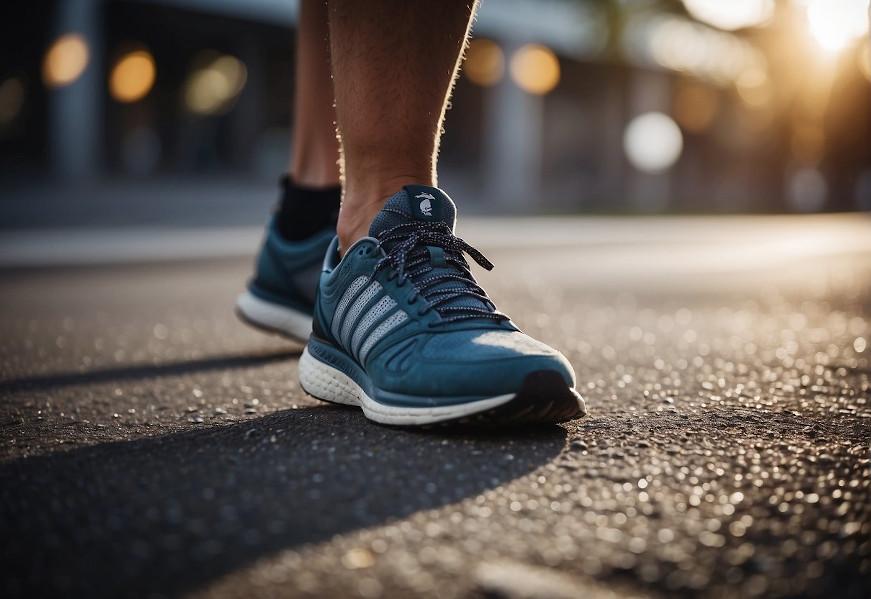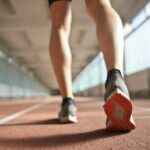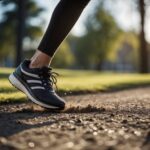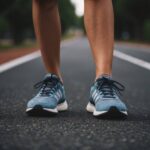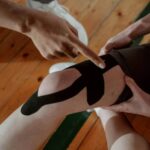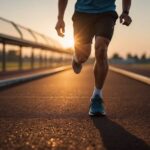Running is a high-impact activity that places substantial stress on the body, particularly on the joints and connective tissues. When the foot strikes the ground during a run, a force known as the ground reaction force is generated. This force is a direct result of the body’s mass and acceleration interacting with the ground, and it is a key determinant in the overall impact force experienced by the runner.
The intensity of running impact force is a crucial factor in both performance and injury prevention. Studies have shown that the peak vertical ground reaction force is significantly higher during running compared to walking, even when both are performed at the same intensity. This increased force, coupled with a higher frequency of steps in running, amplifies the potential for orthopedic stress. Runners and coaches often focus on optimizing running mechanics to manage these forces, with an aim to enhance performance while mitigating injury risk.
Understanding the biomechanics of running impact force is not just of academic interest; it is also practical for runners looking to improve their technique. Efficient running mechanics can influence the magnitude of impact forces, balancing the vertical and horizontal components to foster better acceleration at the beginning of a stride and reduce overall stress as the foot comes into contact with the ground. With this knowledge, runners can adjust their form to achieve a balance between speed and safety.
Fundamentals of Running Impact Force
When running, every foot strike generates a force that is a crucial factor in both performance and injury prevention. Understanding its physical principles and how the body responds is critical for runners of all levels.
Physics of Running Impact
The impact during running is a function of the action-reaction principle, stating that for every action, there is an equal and opposite reaction. As a runner’s foot strikes the ground, two primary forces are at play:
- Impact Force: This is related to how the runner’s mass interacts with the ground upon foot strike. The magnitude of the impact force can be substantial, often exceeding 2-3 times the runner’s body weight.
- Acceleration: When the foot lands, the ground applies an opposing force to decelerate the runner’s mass, leading to acceleration in the opposite direction.
These forces can be modified by factors such as the runner’s speed, stride length, and surface hardness.
Ground Reaction Forces in Running
Ground Reaction Forces (GRFs) measure the force exerted by the ground on the body in response to the impact during running. They consist of three components:
- Vertical GRF: Corresponds to the body weight component and is characterized by a peak during the initial contact followed by a trough as the runner transitions from landing to pushing off.
- Horizontal GRF: Directly relates to forward acceleration and helps in propelling the runner.
- Lateral GRF: Typically smaller and deals with side-to-side motion, contributing to stability.
To analyze these forces, researchers use advanced equipment like force plates, which quantify the magnitude and direction of GRFs throughout the running stride. Understanding how different footwear affects these forces can provide insights into injury prevention and performance efficiency.
Running Biomechanics and Gait Analysis
Running biomechanics examines how the body moves during a run, focusing on the structure and function of the foot during different phases of the gait cycle. Gait analysis is used to assess and optimize running mechanics, which can help reduce the risk of injury and improve performance.
Foot Strike Patterns
Foot strike patterns during running are categorized based on which part of the foot makes initial contact with the ground. The three principal patterns are:
- Rearfoot strike (RFS): Heel contacts first.
- Midfoot strike (MFS): The center of the foot contacts simultaneously.
- Forefoot strike (FFS): The ball of the foot lands before the heel.
Each pattern influences the biomechanical load and can affect the risk of injury. Research has shown that the stance phase, where the foot is in contact with the ground, generates significant impact force, particularly in RFS patterns.
Stride and Cadence
Stride length and step frequency (cadence) are key components of running gait:
- Stride Length: The distance covered between the initial contact of one foot and the next contact of the same foot.
- Step Frequency: The number of steps taken per unit of time, typically measured in steps per minute.
An optimal ratio of stride length to cadence minimizes energy expenditure and reduces impact forces. A frequent advice is that runners should aim for a cadence of around 180 steps per minute, but optimal cadence can vary based on individual biomechanics.
Force Platform and Wearable Technology Use
Technology plays a critical role in analyzing running gait:
- Force Platforms: These devices measure the forces exerted by the feet during contact with the ground, providing data on stride dynamics and the phases of the running cycle: the stance and swing time.
- Wearable Technology: Tools like accelerometers in wearable devices capture data on the runner’s movements. They offer insights into foot strike patterns, stride length, and overall form while running in real-world conditions.
The data from these technologies can be used to identify biomechanical patterns that may predispose runners to injuries or inefficiencies and can inform tailored interventions for performance enhancement.
Impact Force and Running Injuries
Running injuries are often associated with the forces that the body absorbs during the impact with the ground. Ground reaction forces, particularly the vertical component, can be substantial, and their management is crucial to prevent injuries specific to running.
Common Running Injuries
Running injuries typically involve the lower extremities and can range from acute to chronic conditions. Common injuries include:
- Plantar fasciitis: Characterized by heel pain, often a result of repetitive stress and inadequate footwear.
- Achilles tendinitis: Involves pain along the Achilles tendon caused by increased strain.
- Runner’s knee (patellofemoral pain syndrome): A condition experienced as pain around the kneecap.
- Iliotibial band syndrome (ITBS): Leg pain associated with the ligament that runs down the outside of the thigh from hip to shin.
These injuries often originate from or are exacerbated by high impact forces during foot strike, which can lead to an accumulation of stress on muscles, tendons, and bones.
Stress Fractures and Overuse Injuries
Stress fractures and overuse injuries are significant concerns among runners:
| Injuries | Impact Force Relation |
|---|---|
| Stress fractures | Caused by repetitive force, often exacerbated by impact loading. |
| Overuse injuries | Result from chronic stress without sufficient recovery. |
They occur when the repetitive force of the foot striking the ground overwhelms the bone’s ability to repair itself. Runners with a history of overuse injuries or stress fractures may need to pay closer attention to the impact forces they encounter when running, possibly through biomechanical assessment and adjusting training regimens to mitigate injury risk.
Effects of Running Shoes and Surfaces
The interplay between running shoes and surfaces plays a crucial role in dictating ground reaction forces and the overall impact on a runner’s performance and risk of injury. These factors are significant in how they modify the interaction between the foot and the ground.
Shoe Cushioning and Support
Shoe cushioning is designed to mitigate the forces exerted on the runner’s body. Research indicates that running shoes with high cushioning can lead to increased leg stiffness. Fast-paced running in highly cushioned shoes tends to increase both the impact peak and loading rate, which are critical factors for injury prevention and performance. Additionally, the support provided by running shoes adds to the stability of the foot, but the level required may vary based on an individual’s gait and biomechanics.
Surface Impact on Running Performance
Different running surfaces affect runners in unique ways. A hard surface, like asphalt, lacks cushioning, resulting in the majority of the impact force being transferred to the runner’s legs. In contrast, softer surfaces, such as dirt trails, offer natural cushioning, helping to absorb some of the shock during footstrike. This cushioning can decrease the loading rate and reduce the strain on joints and tissues, potentially minimizing the risk of injury.
Physiological Considerations
In understanding running impact forces, one must consider the body’s intrinsic response mechanisms and the stresses placed on the joints. The human body is adapted to handle a degree of impact naturally, yet the forces involved in running can still lead to potential injuries, particularly in the knee, hip, ankle, and joints.
Body’s Response to Impact Forces
When an individual runs, the body experiences vertical ground reaction forces (vGRF) that can be significant, often exceeding two to three times the runner’s body weight. The physiological response to these forces begins at the ankle joint, which acts as a primary shock absorber, followed by the knee and hip joints which further dissipate the energy. The integrity of these joints and their ability to withstand repetitive stress is paramount for a runner’s performance and injury prevention.
Key physiological adaptations in response to impact forces:
- Muscle Tuning: The body preemptively adjusts the stiffness of the leg muscles before foot strike to optimize the interaction with the ground.
- Energy Absorption: Soft tissues within the joints, such as cartilage and menisci in the knee, absorb shock to protect underlying bone and reduce peak loading.
Joint Stress and Impact
Joints bear significant stress during running, and their health is essential for managing impact forces. The knee joint, in particular, is a critical site for injury, as it must cope with high shear and compressive forces. Meanwhile, the hip and ankle joints also play a role in managing impact through their respective contributions to shock absorption and stability.
Joint-specific considerations regarding impact:
- Knee: Repetitive loading can lead to increased stress on the knee joint, which may contribute to conditions such as patellofemoral pain syndrome.
- Hip: Proper hip alignment and strength are crucial in distributing forces and minimizing impact-related strain.
- Ankle: Adequate ankle flexibility and strength are necessary for effective shock absorption.
By understanding these physiological influences, one can better appreciate the complexities involved in managing running impact forces and the importance of maintaining joint health.
Impact Force Modification Strategies
In an effort to enhance running performance and reduce the risk of injuries, runners and professionals focus on strategies aimed at mitigating impact force. These approaches span from training adjustments to seeking expert guidance.
Training Techniques for Impact Reduction
Forefoot Strike Training: Adopting a forefoot strike technique, where the ball of the foot makes initial ground contact, can reduce impact loading compared to a heel strike pattern. Recreational runners who transition to a forefoot strike may experience a shift in the distribution of impact forces, potentially lowering the risk of lower limb stress fractures.
- Cadence Adjustment: Increasing one’s running cadence, or the number of steps taken per minute, has shown promise in decreasing peak impact force. Specific studies suggest that a slight increment in steps, around 7%, can effectively lower impact loading during running.
Role of Professional Advice
Physical Therapists: Consulting with a physical therapist can provide tailored training recommendations. They assess individual running gait and biomechanics to offer personalized advice on modifying running impact force.
Educational Interventions: Physical therapists often educate runners on proper running form and injury prevention strategies. They can also guide the strategic use of footwear or training equipment, such as metronomes, to assist runners in achieving their desired cadence and thereby modifying impact forces.
Analyzing Running Impact Force
In the analysis of running impact force, one primarily considers the peak impact and active peak forces experienced by runners. Utilizing both laboratory settings and real-world applications allows for comprehensive understanding and assessment.
Laboratory Assessments
In laboratory environments, the analysis of running impact force relies on controlled settings to accurately measure the forces acting on a runner’s body. Peak impact force is recorded using force plates that measure the vectors along the vertical and horizontal axis. This data provides insight into the interaction between the runner and the ground during the contact phase. Moreover, active peak force, which occurs later in the ground contact phase, is evaluated to understand the runner’s propulsion efficiency.
The tools typically used in a lab setting include:
- Force plates: These devices measure the ground reaction forces in three dimensions, capturing data on vertical load and horizontal shear forces.
- Motion capture systems: Often combined with force plates, these systems record the movement of reflective markers attached to the runner’s body to deduce the mechanical patterns of running.
- Chest straps and wearable sensors: These can measure the runner’s physiological responses in tandem with impact forces to provide a broader context for performance and potential injury risk.
Real-World Applications
The study of running impact force isn’t confined to a lab. Real-world applications involve the use of portable devices that gather data during actual training sessions. A runner may wear a chest strap equipped with accelerometers and GPS to collect information regarding the chest’s motion and the overall running dynamics. Such tools help in quantifying the peak impact forces outside of the controlled laboratory setting.
Key measurements in real-world scenarios include:
- Peak Impact: The maximum force exerted on the runner’s body at foot strike.
- Active Peak: The subsequent peak of force showcasing the body’s response to propulsion.
This field data can inform runners about their mechanics in familiar terrain, offering practical insights for optimizing performance and reducing injury risk.
Advancements in Impact Force Research
Recent developments in the understanding of impact forces during running highlight both the progress in biomechanical analysis and the pursuit of injury prevention strategies.
Innovations in Biomechanics
Researchers now utilize advanced biomechanical modeling to decipher the effects of running on the human body. Ground reaction forces, particularly the impact peak and overall peak, play a vital role in understanding the mechanics behind running-related injuries. Novel studies illustrate that runners, commonly heel-strikers, exhibit two notable vertical ground-reaction force peaks during running. State-of-the-art motion capture technology paired with force plates has allowed for more precise measurements of these forces.
The impact peak is a critical area of study due to its association with common injuries like plantar fasciitis. Innovations in footwear have also stemmed from these insights, with maximalist shoes now designed to alter foot-ground reaction forces to minimize the risk of injury. Research shows these shoes may change biomechanics both before and after a run.
To summarize the advancements:
- Biomechanical Modeling: Improved accuracy in measuring impact forces.
- Footwear Technology: Development of shoes aimed at reducing injury risk.
Future Directions for Impact Reduction
The ongoing development of impact force research is steering towards an integrated approach that combines biomechanical data with material sciences and design theory. The future seems promising as scientists are aiming to create running shoes that not only adapt to the runner’s biomechanics but also help in actively reducing impact forces.
There is a growing focus on predictive modeling to forecast how different footwear affects foot-ground reaction forces over time. This focus on anticipatory research is a leap forward, aiming to curb the incidence of injuries proactively rather than reactively.
Anticipated advances are as follows:
- Predictive Modeling: Using AI to predict the long-term effects of footwear on impact forces.
- Integrated Design: Combining biomechanical insights with materials engineering for the next generation of running shoes.
